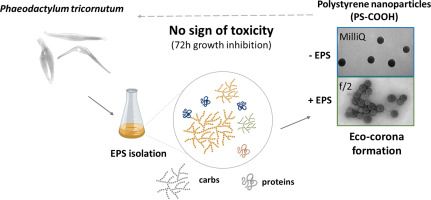当前位置:
X-MOL 学术
›
Sci. Total Environ.
›
论文详情
Our official English website, www.x-mol.net, welcomes your feedback! (Note: you will need to create a separate account there.)
Interplay between extracellular polymeric substances (EPS) from a marine diatom and model nanoplastic through eco-corona formation.
Science of the Total Environment ( IF 9.8 ) Pub Date : 2020-04-06 , DOI: 10.1016/j.scitotenv.2020.138457 Giacomo Grassi 1 , Edi Gabellieri 2 , Patrizia Cioni 2 , Eugenio Paccagnini 3 , Claudia Faleri 3 , Pietro Lupetti 3 , Ilaria Corsi 1 , Elisabetta Morelli 2
Science of the Total Environment ( IF 9.8 ) Pub Date : 2020-04-06 , DOI: 10.1016/j.scitotenv.2020.138457 Giacomo Grassi 1 , Edi Gabellieri 2 , Patrizia Cioni 2 , Eugenio Paccagnini 3 , Claudia Faleri 3 , Pietro Lupetti 3 , Ilaria Corsi 1 , Elisabetta Morelli 2
Affiliation

|
The occurrence of nanoplastics in oceans' surface waters is no more a hypothesis and it could severely affect marine organisms from different trophic levels. Nanoscale particles interaction with dissolved natural organic matter (NOM) significantly influence their behaviour and consequently bioavailability and toxicity to marine species. Extracellular polymeric substances (EPS) are among the main components of the NOM pool in seawater yet have been so far little investigated for their effect in altering the physical-chemical properties of nanosized objects. Here we employed EPS from marine diatom Phaeodactylum tricornutum to study the evolution of an eco-corona formation upon incubation with 60 nm carboxylated polystyrene nanoparticles (PS-COOH NPs), as proxy for nanoplastics in seawater. EPS significantly reduced PS-COOH NPs aggregation rate compared to biomolecule free natural seawater (NSW) and caused the formation of complexes constituted by both carbohydrate and protein components. Size Exclusion Chromatography (SEC) revealed four main distinct groups of peaks, spanning from high (>100 kDa) to low molecular weight (20 kDa) molecules, characterized by a high chemical heterogeneity. The lowering of the chromatographic signals detected after EPS incubation with PS-COOH NPs, mainly in the eluates at high molecular weight, suggests that an important fraction of EPS remained adsorbed on PS-COOH NPs. In agreement, SDS-PAGE analysis of proteins adsorbed on PS-COOH showed the occurrence of an eco-corona formed by proteins in the range of molecular weight 30-100 kDa. No toxicity to diatoms was observed upon PS-COOH exposure (72 h, 1-100 mg L-1) even by adding a further source of exogenous EPS during exposure. Moreover, the addition of EPS reduced ROS production, even when cells were incubated with PS-COOH NPs at 10 and 50 mg L-1, suggesting an antioxidant scavenging activity of EPS.
中文翻译:

来自海洋硅藻的胞外聚合物 (EPS) 与模型纳米塑料之间通过生态电晕形成的相互作用。
海洋表层水中纳米塑料的出现不再是一种假设,它可能会严重影响不同营养水平的海洋生物。纳米级颗粒与溶解的天然有机物 (NOM) 的相互作用显着影响它们的行为,从而影响其对海洋物种的生物利用度和毒性。细胞外聚合物 (EPS) 是海水中 NOM 池的主要成分之一,但迄今为止很少有人研究它们对改变纳米物体物理化学性质的影响。在这里,我们使用来自海洋硅藻 Phaeodactylum tricornutum 的 EPS 来研究与 60 nm 羧化聚苯乙烯纳米粒子 (PS-COOH NPs) 孵育后生态电晕形成的演变,作为海水中纳米塑料的代表。与不含生物分子的天然海水 (NSW) 相比,EPS 显着降低了 PS-COOH NPs 的聚集率,并导致形成由碳水化合物和蛋白质成分构成的复合物。尺寸排阻色谱 (SEC) 揭示了四个主要不同的峰组,从高 (>100 kDa) 到低分子量 (20 kDa) 分子,其特征在于高化学异质性。EPS 与 PS-COOH NPs 孵育后检测到的色谱信号降低,主要在高分子量的洗脱液中,表明 EPS 的重要部分仍然吸附在 PS-COOH NPs 上。一致地,吸附在 PS-COOH 上的蛋白质的 SDS-PAGE 分析显示,发生了由分子量 30-100 kDa 范围内的蛋白质形成的生态电晕。在 PS-COOH 暴露(72 小时,1-100 mg L-1) 甚至在暴露期间添加外源 EPS 的进一步来源。此外,即使细胞与 10 和 50 mg L-1 的 PS-COOH NPs 一起孵育,EPS 的添加也减少了 ROS 的产生,这表明 EPS 具有抗氧化清除活性。
更新日期:2020-04-06
中文翻译:

来自海洋硅藻的胞外聚合物 (EPS) 与模型纳米塑料之间通过生态电晕形成的相互作用。
海洋表层水中纳米塑料的出现不再是一种假设,它可能会严重影响不同营养水平的海洋生物。纳米级颗粒与溶解的天然有机物 (NOM) 的相互作用显着影响它们的行为,从而影响其对海洋物种的生物利用度和毒性。细胞外聚合物 (EPS) 是海水中 NOM 池的主要成分之一,但迄今为止很少有人研究它们对改变纳米物体物理化学性质的影响。在这里,我们使用来自海洋硅藻 Phaeodactylum tricornutum 的 EPS 来研究与 60 nm 羧化聚苯乙烯纳米粒子 (PS-COOH NPs) 孵育后生态电晕形成的演变,作为海水中纳米塑料的代表。与不含生物分子的天然海水 (NSW) 相比,EPS 显着降低了 PS-COOH NPs 的聚集率,并导致形成由碳水化合物和蛋白质成分构成的复合物。尺寸排阻色谱 (SEC) 揭示了四个主要不同的峰组,从高 (>100 kDa) 到低分子量 (20 kDa) 分子,其特征在于高化学异质性。EPS 与 PS-COOH NPs 孵育后检测到的色谱信号降低,主要在高分子量的洗脱液中,表明 EPS 的重要部分仍然吸附在 PS-COOH NPs 上。一致地,吸附在 PS-COOH 上的蛋白质的 SDS-PAGE 分析显示,发生了由分子量 30-100 kDa 范围内的蛋白质形成的生态电晕。在 PS-COOH 暴露(72 小时,1-100 mg L-1) 甚至在暴露期间添加外源 EPS 的进一步来源。此外,即使细胞与 10 和 50 mg L-1 的 PS-COOH NPs 一起孵育,EPS 的添加也减少了 ROS 的产生,这表明 EPS 具有抗氧化清除活性。


























 京公网安备 11010802027423号
京公网安备 11010802027423号